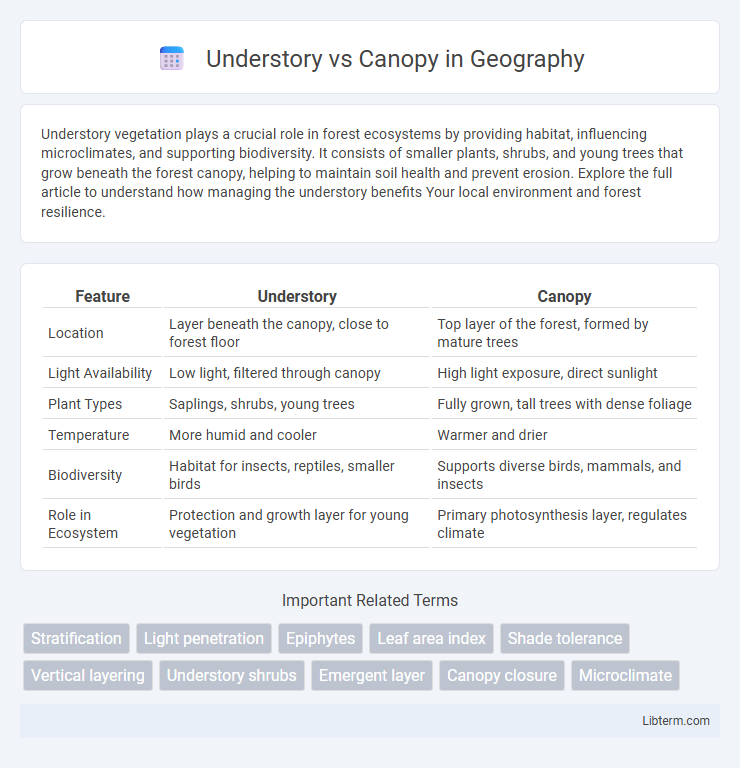Understory vegetation plays a crucial role in forest ecosystems by providing habitat, influencing microclimates, and supporting biodiversity. It consists of smaller plants, shrubs, and young trees that grow beneath the forest canopy, helping to maintain soil health and prevent erosion. Explore the full article to understand how managing the understory benefits Your local environment and forest resilience.
Table of Comparison
| Feature | Understory | Canopy |
|---|---|---|
| Location | Layer beneath the canopy, close to forest floor | Top layer of the forest, formed by mature trees |
| Light Availability | Low light, filtered through canopy | High light exposure, direct sunlight |
| Plant Types | Saplings, shrubs, young trees | Fully grown, tall trees with dense foliage |
| Temperature | More humid and cooler | Warmer and drier |
| Biodiversity | Habitat for insects, reptiles, smaller birds | Supports diverse birds, mammals, and insects |
| Role in Ecosystem | Protection and growth layer for young vegetation | Primary photosynthesis layer, regulates climate |
Understanding Forest Layers: Understory and Canopy
The understory, consisting of smaller trees and shrubs, absorbs filtered sunlight beneath the dense canopy layer formed by tall, mature trees. The canopy acts as a protective barrier regulating temperature, humidity, and light penetration, which directly affects the biodiversity and ecological functions within the understory. Understanding the complex interactions between understory and canopy layers is essential for forest management, conservation, and habitat restoration efforts.
Defining the Understory Layer
The understory layer refers to the vegetation and plant life growing beneath the forest canopy but above the forest floor, characterized by shorter trees, shrubs, and young saplings adapted to lower light conditions. This layer plays a crucial role in forest ecology by providing habitat for diverse wildlife and contributing to nutrient cycling. Unlike the canopy, which forms the uppermost continuous layer of mature tree crowns, the understory regulates microclimate and supports biodiversity within a forest ecosystem.
What is the Canopy Layer?
The canopy layer is the uppermost layer of a forest, consisting of densely packed tree crowns that form a continuous roof over the understory. It plays a crucial role in regulating light penetration, temperature, and moisture levels within the ecosystem, supporting diverse wildlife and plant species adapted to this environment. This layer intercepts sunlight, enabling photosynthesis while protecting the lower layers from harsh weather conditions.
Key Differences Between Understory and Canopy
The understory consists of smaller trees and shrubs located beneath the canopy layer, receiving limited sunlight and serving as a crucial habitat for shade-tolerant species. The canopy, forming the uppermost layer of the forest, is composed of tall, mature trees that capture most of the sunlight and regulate the forest microclimate. Key differences include light exposure, plant height, species composition, and ecological functions within forest ecosystems.
Plant Species Found in Understory vs Canopy
Understory plant species typically include shade-tolerant shrubs, ferns, and young trees such as saplings of oaks and maples, adapted to low light and high humidity conditions beneath the canopy. Canopy species consist mainly of taller, fast-growing trees like emergents, including species like mahogany, kapok, and various hardwoods that dominate the forest layer with their broad, sun-exposed crowns. The diversity in plant species between understory and canopy reflects adaptations to different light availability, moisture, and ecological roles within forest ecosystems.
Light Availability: Understory vs Canopy
Light availability varies significantly between the understory and canopy layers of a forest, with the canopy receiving the highest intensity of direct sunlight due to its position at the top. The understory experiences limited light, often filtered and diffused as it passes through the dense leaves and branches of the canopy, resulting in lower photosynthetic activity. This difference in light availability influences plant adaptations and biodiversity, as species in the understory typically evolve to thrive under low-light conditions, while canopy plants maximize light capture.
Role of Understory and Canopy in Forest Ecosystems
The understory and canopy play crucial roles in forest ecosystems by supporting biodiversity and regulating microclimates. The canopy, formed by the upper layer of trees, captures sunlight and drives photosynthesis, creating habitats for many arboreal species and influencing temperature and moisture levels below. The understory consists of smaller trees and shrubs that provide shelter and food for insects, birds, and mammals while aiding in nutrient cycling and forest regeneration.
Wildlife Habitats: Comparing Understory and Canopy
The understory provides dense, sheltered habitats ideal for small mammals, reptiles, and ground-nesting birds, offering protection and abundant food resources like berries and insects. The canopy, with its elevated branches and lush foliage, supports a diverse range of arboreal wildlife such as monkeys, birds, and insects adapted to life above ground. Both layers create vital, interconnected ecosystems essential for maintaining biodiversity and ecological balance in forest environments.
Environmental Impacts on Understory and Canopy Layers
The understory and canopy layers of a forest experience distinct environmental impacts that shape biodiversity and ecosystem functions. The canopy layer primarily mitigates temperature fluctuations and controls light penetration, impacting photosynthesis rates and microclimate stability below. The understory, receiving filtered sunlight and higher humidity, supports unique plant and animal species sensitive to changes in canopy cover, pollution, and invasive species, with alterations in either layer disrupting nutrient cycling and habitat quality.
Conservation Strategies for Understory and Canopy Protection
Effective conservation strategies for understory protection emphasize maintaining habitat complexity by minimizing soil disturbance and preserving native plant diversity to support wildlife and nutrient cycling. Canopy protection strategies prioritize preventing deforestation through sustainable logging, implementing protected areas, and encouraging reforestation to maintain microclimate regulation and carbon sequestration. Integrating both layers' conservation enhances forest resilience, biodiversity preservation, and long-term ecosystem stability.
Understory Infographic

 libterm.com
libterm.com